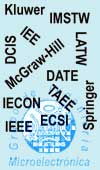
Mapa Web

Localización

Noticias

Info Santander

Gestión BD

|
| GIM>Investigación>Publicación |
| PUBLICACION |
| |
| Ficha completa |
| Título: | CMD, an automated design program for blood pressure sensing capacitive MEMS |
| Tipo: | Comunicaciones a congresos internacionales |
| Lugar: | 11th International Conference on Nanosciences & Nanotechnologies (NN14) |
| Fecha: | 2014-07 |
| Autores: |
Jose Angel Miguel
Yolanda Lechuga
Mar Martínez
|
| Líneas: |
Métodos de test de circuitos integrados digitales y mixtos
|
| Proyectos: |
Extensión de la actividad útil de los stent cardiovasculares inteligentes...
|
| ISBN: | |
| Fichero: |
|
| Resumen: | Intelligent stents (e-stents), capable of sensing and transmitting real-time measurements of physiological signals related to blood vessel occlusion, such as pressure and flow velocity, have been proposed as a useful tool to In-Stent Restenosis (ISR) early detection and follow-up without patient hospitalization. The simplest implantable version of an e-stent of this kind is made up of a couple of capacitive MEMS sensors to acquire blood pressure measurements and an inductance to form an LC tank to transmit this data by inductive coupling.
As expected, reliability over an extended period of time is a critical issue concerning implantable electronic devices. Particularly, because of its small thickness and high deformation profile, the MEMS sensor’s diaphragm can be considered to be the most vulnerable part of the e-stent system. An automated program (CMD) for implantable capacitive MEMS pressure sensor design has been developed on Matlab environment. This program provides the most suitable sensor topology, based on a set of data specified by the user, such as the fabrication technology, the diaphragm shape, the pressure range to be sensed, etc. First, analytical displacement and capacitance solutions are provided, in order to have an initial approximation to sensor sensitivity. Once the design requirements are satisfied, two independent code files are generated. A first file is based on Ansys programming language and contains the sensor model, as well as a set of physical and electrical analysis to be performed. This file is ready to be run on Ansys, providing accurate results about sensor deflection, capacitance, stress and sensitivity. A second file, based on SKILL language, contains the sensor layout model to be run on Cadence environment. By this way, the whole sensor design process is unified in a single program, simplifying the process, as well as the detection and correction of design errors.
|
|
|








